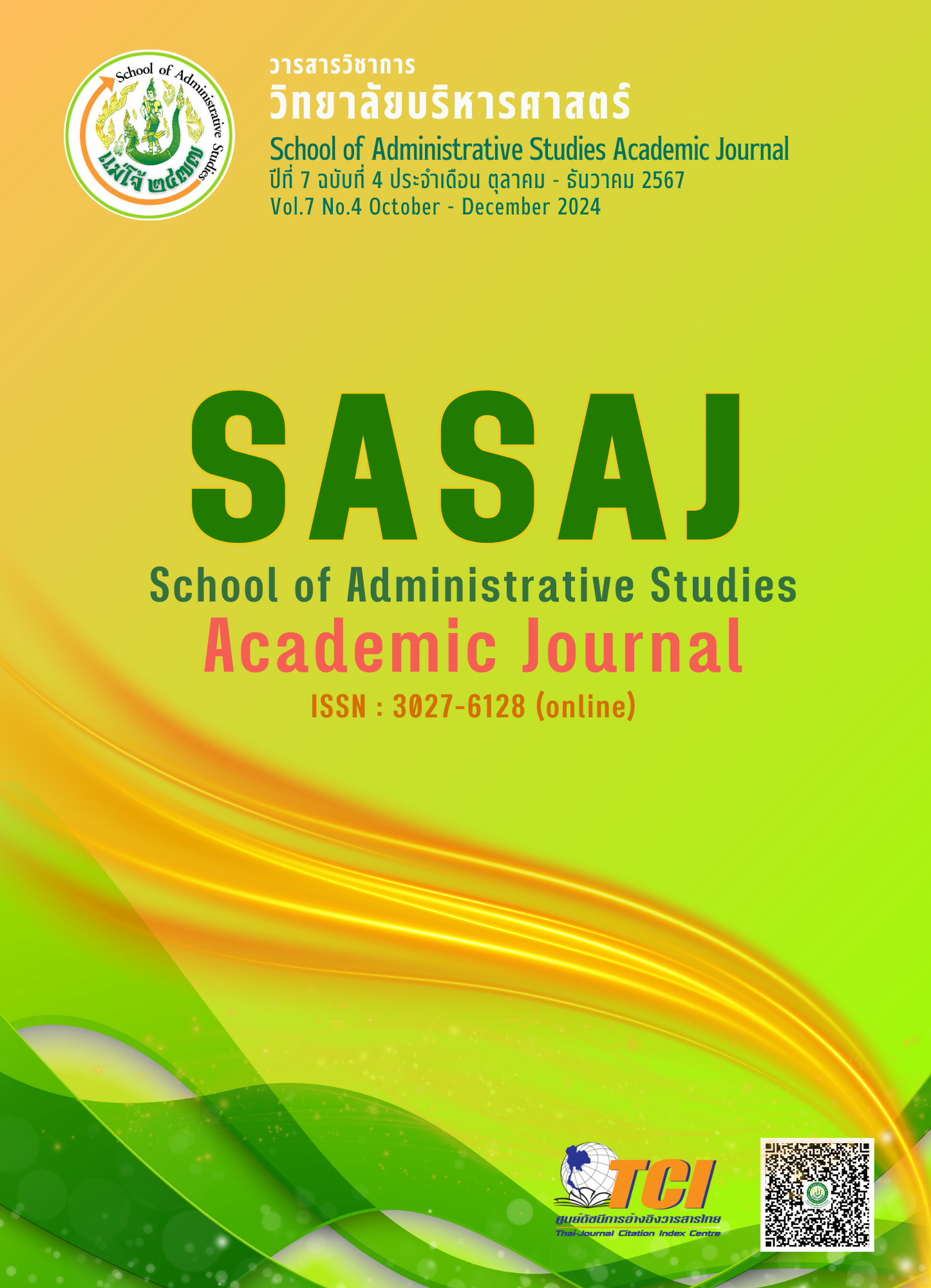Legal Measures to Promote the Right to breathe in Clean Air : A Case Study of China, United States, and Singapore.
Main Article Content
Abstract
The purpose of this research was to reflect the importance of the right to breathe clean air, which required concrete policies. It employed the documentary research method involving the search for and collection of legal data from a variety of domestic and worldwide sources. The research would benefit the development of air pollution control agencies to promote the people's good health.
One might argue that Thailand’s current environmental laws required the application of multiple statutes in the effort to reduce air pollution. Therefore, the research conclusions based on the actual problems and matters of fact concerning the existing law enforcement were as follows. Firstly, local administrative organizations had to make campaigns to raise public awareness of self-protection against unclean air together with the provision of health advice on the basis of reliable international standards. Secondly, there should be a central organization that might serve as an ad-hoc center (in time of occurrence of health-threatening dust situation) in order to integrate law enforcement collaboration in a rapid, comprehensive, and thorough manner. Thirdly, the law amendment should focus on the control of sources or polluters, and preventive measures with suitable penalties (covering both domestic and transboundary pollutions). This would raise the awareness of not taking any environment-threatening actions among individuals or entities that could probably cause air pollutions.
In this regard, the United Nations has recognized the “right to a clean, healthy, and sustainable environment” as a human right, and encouraged its member states to enhance their capabilities to ensure their population’s enjoyment of clean, healthy, and sustainable environment. Therefore, Thailand should urgently develop specific laws in achieving concrete solutions in order to sustainably ensure the rights of Thai people to breathe clean air.
Article Details

This work is licensed under a Creative Commons Attribution-NonCommercial-NoDerivatives 4.0 International License.
ลิขสิทธิ์
References
กิตติมา อรุณพูลทรัพย์. (2563). การยกระดับมาตรการทางกฎหมายในการป้องกัน และแก้ไขปัญหาฝุ่นละออง PM 2.5. สืบค้นจาก https://www.senate.go.th/view/93/กฎหมายน่ารู้/TH-TH?year=&page101=6
ฉัตรสุมน พฤฒิภิญโญ. (2560). กฎหมายกับการควบคุมมลภาวะทางอากาศ. วารสารกฎหมายสุขภาพและสาธารณสุข, 3(3), 401- 424.
พวงผกา บุญโสภาคย์, ประสาน บุญโสภาคย์, และ ณปภัช นธกิจไพศาล. (2561). มาตรการทางกฎหมายในการป้องกันและควบคุมมลพิษทางอากาศที่เกิดขึ้นจากโรงงานอุตสาหกรรม. วารสารเกษมบัณฑิต, 19(ฉบับพิเศษ), 118–129.
สำนักงานคณะกรรมการกฤษฎีกา. (2561). พระราชบัญญัติส่งเสริมและรักษาคุณภาพสิ่งแวดล้อมแห่งชาติ พ.ศ. 2535. สืบค้นจาก https://krisdika.ocs.go.th/librarian/get?sysid=396089&ext=htm
สุรสม กฤณะจูฑะ. (2550). สิทธิสุขภาพ สิทธิมนุษยชน. นทบุรี: สำนักวิจัยสังคมและสุขภาพ.
เสน่ห์ จามริก. (2546). สิทธิมนุษยชนไทยในสถานการณ์สากล. กรุงเทพฯ: สำนักวิจัยและพัฒนา สถาบันชุมชนพัฒนา.
อภิรัฐ ดีทองอ่อน. (2559). มาตรการทางกฎหมายในการควบคุมมลพิษทางอากาศอันเกิดจากการเผาในที่โล่งในภาคเกษตรกรรม (วิทยานิพนธ์ปริญญามหาบัณฑิต).มหาวิทยาลัยธรรมศาสตร์, กรุงเทพฯ
Association of Southeast Asian Nation (ASEAN). (2021). ASEAN Agreement on Transboundary Haze Pollution. Retrieved from https://asean.org/wp-content/uploads/2021/01/ASEANAgreementonTransboundaryHaze Pollution-1.pdf
Association of Southeast Asian Nation Secretariat (ASEAN Secretariat). (2021). Action: ASEAN Agreement on Transboundary Haze Pollution. Retrieved from https://hazeportal.asean.org/action/asean-agreement-on-transboundary-haze-pollution/
Climate and Clean Air Coalition Secretariat (CCAC Secretariat). (2023). In a World Full of Dirty Air, Regional Agreements on Air Pollution Offer a Glimmer of Hope Retrieved from https://www.ccacoalition.org/news/world-full-dirty-air-regional-agreements-air-pollution-offer-glimmer-hope
Environmental Protection Agency (EPA). (2024). Criteria Air Pollutants: NAAQS Table. Retrieved from https://www.epa.gov/criteria-air-pollutants/naaqs-table
Food and Agriculture Organization of the United Nations (FAO). (2019). Transboundary Haze Pollution Act 2014 (No. 24 of 2014). Retrieved from https://www.fao.org/faolex/results/details/en/c/LEX-FAOC137119/
International Energy Agency (IEA). (2022). Law on Air Pollution Prevention and Control. Retrieved from https://www.iea.org/policies/11896-law-on-air-pollution-prevention-and-control
International Institute for Sustainable Development (IISD). (2022). UNGA Recognizes Human Right to Clean, Healthy, and Sustainable Environment. Retrieved from https://sdg.iisd.org/news/unga-recognizes-human-right-to-clean-healthy-and-sustainable-environment/
Organisation for Economic Co-operation and Development (OECD). (2006). Environmental Compliance and Enforcement in CHINA: An Assessment of Current Practices and Ways Forward. Retrieved from https://www.oecd.org/environment/outreach/37867511.pdf
Roundtable on Sustainable Palm Oil (RSPO) (2024). Secretariat. Retrieved from https://rspo.org/who-we-are/governance/secretariat/
United Nations (UN). (2022). The human right to a clean, healthy and sustainable environment. Retrieved from https://digitallibrary.un.org/record/3982508?ln=en&v=pdf
United Nations Environment Programme (UNEP). (2010). Air Pollution: Promoting regional cooperation. Retrieved from http://www.rrcap.ait.ac.th/Publications/Air%20Pollution%20-%20Promoting%20Regional%20Cooperation.pdf
United Nations Economic and Social Commission for Asia and the Pacific (UNESCAP). (2023). A brief Introduction. Retrieved from https://www.unescap.org/sites/default/d8files/2023-09/Air-pollution-infographics-30-Aug-2023.pdf
United Nations Economic and Social Commission for Asia and the Pacific (UNESCAP). (2024). Clean Air. Retrieved from https://www.unescap.org/our-work/environment-and-development/climate-and-clean-air/clean-air


